Originally posted on December 5, 2023 @ 12:02 am
Garam masala is a popular spice blend used in Indian cooking, but if you don’t have it on hand or want to try something different, there are several substitutes you can use. In this guide, we will explore the best masala spice substitutes and how to use them in your favorite dishes.
Table of Contents
Key Takeaways:
- Curry powder is a versatile substitute for garam masala, offering similar complexity of flavors and aromas.
- A blend of cumin and allspice can mimic the flavors of clove, cinnamon, pepper, and nutmeg found in garam masala.
- Create your own masala spice blend by combining equal parts ground fennel seeds, caraway seeds, and cinnamon.
- Experiment with masala spice substitutes in traditional Indian recipes or try them in other cuisines for a unique twist.
- When cooking with spices, start with small amounts, taste as you go, and consider the balance of flavors.
What is Garam Masala?
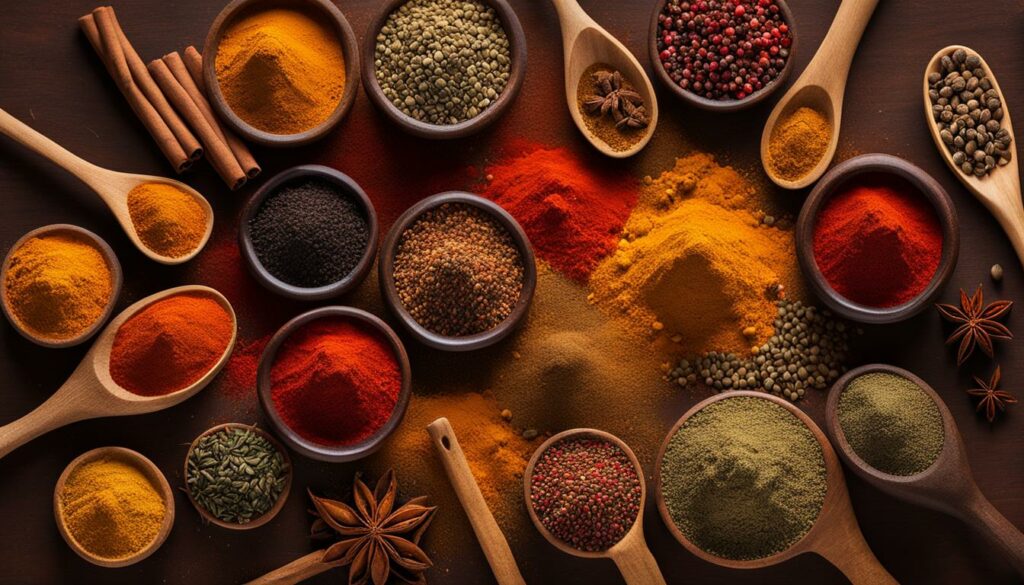
Garam masala is a versatile Indian spice blend that adds a unique flavor and aroma to dishes. It is a staple in Indian cuisine and is used in a variety of savory and sweet dishes. The term “garam” means “hot” in Hindi, referring to the warming properties of the spices in the blend. Traditionally, garam masala is made by grinding together a combination of spices like cumin, coriander, cardamom, cloves, cinnamon, black pepper, and nutmeg. These spices are carefully selected to create a balance of flavors that are both aromatic and complex.
The combination of spices in garam masala can vary depending on the region and personal preferences. Some variations may include additional spices like bay leaves, fennel seeds, mustard seeds, turmeric, and mace. Each blend has its own unique flavor profile, with some being more mild and others more bold and spicy.
Garam masala is a key ingredient in many traditional Indian dishes, such as curries, biryanis, and kebabs. It adds depth and richness to these dishes and enhances the overall flavor. Whether you purchase a pre-packaged garam masala or make your own blend at home, incorporating this Indian spice into your cooking will elevate your dishes to new levels of deliciousness.
Store-Bought Garam Masala vs. Homemade Garam Masala
Garam masala, a popular Indian spice blend, can be conveniently purchased in pre-packaged form at grocery stores. This store-bought version offers a quick and easy solution for adding the rich flavors of garam masala to your dishes. However, if you prefer a more customized flavor profile, making your own homemade garam masala is a fantastic option.
When comparing store-bought garam masala with homemade garam masala, there are a few key differences to consider. The store-bought version is a convenient choice for those who may not have all the individual spices on hand or simply prefer the convenience of a pre-packaged blend. On the other hand, making your own garam masala allows you to control the quality and freshness of the spices, as well as tailor the flavor to your personal preferences.
Homemade garam masala often boasts a more intense flavor and aroma compared to store-bought blends. This is because the spices are freshly ground and combined in the desired ratios, resulting in a robust and vibrant spice blend. Additionally, making your own garam masala gives you the freedom to experiment with different spice combinations, allowing you to create a blend that perfectly suits your taste buds.
Table: Comparison between Store-Bought and Homemade Garam Masala
| Store-Bought Garam Masala | Homemade Garam Masala | |
|---|---|---|
| Convenience | Ready-to-use | Requires grinding and blending |
| Flavor | Mild to medium | Intense and customizable |
| Aroma | Moderate | Strong and fragrant |
| Freshness | Varies | Freshly ground spices |
| Customization | Limited | Flexibility to adjust spice ratios |
“Making your own garam masala can be a rewarding culinary experience, allowing you to create a unique spice blend that adds depth and complexity to your dishes.”
Ultimately, whether you choose store-bought or homemade garam masala depends on your personal preferences and the level of control you desire over the flavors in your dishes. Both options can contribute to delicious and authentic Indian cuisine, so feel free to explore and experiment with different spice blends to find your perfect garam masala substitute.
Substitute 1 – Curry Powder
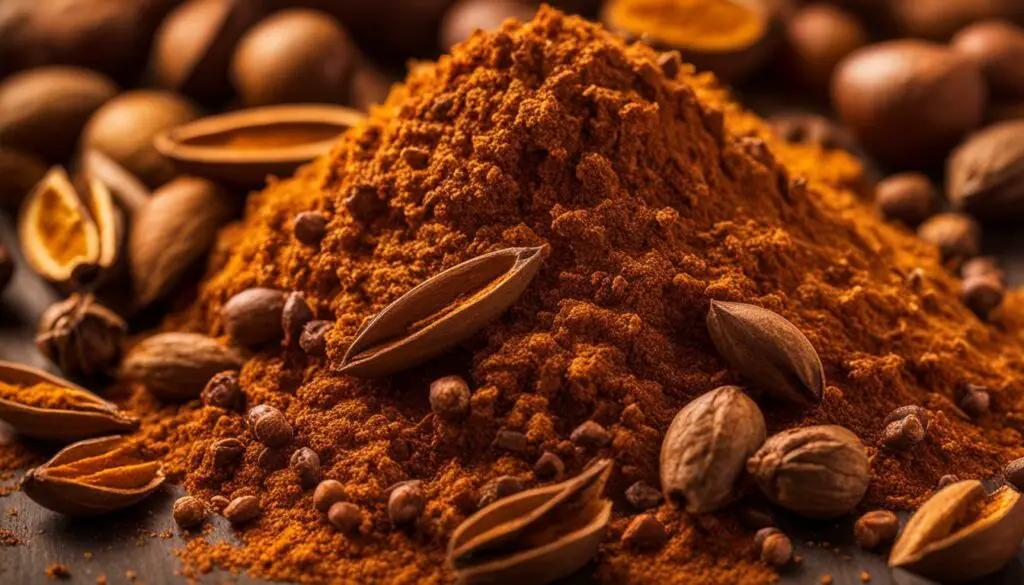
One of the most popular substitutes for garam masala is curry powder. While curry powder has a different flavor profile, it still provides a complex blend of spices that can enhance your dishes. When using curry powder as a substitute, it is best to maintain a 1:1 ratio with garam masala to achieve a similar flavor. Experiment with different brands of curry powder to find the one that suits your taste preferences.
Curry powder typically contains spices such as coriander, cumin, turmeric, fenugreek, and chili peppers. These spices offer a rich and aromatic taste that can add depth to your recipes. While the flavor may differ slightly from garam masala, curry powder is a versatile substitute that can be used in a variety of Indian dishes and other cuisines as well.
The table below provides a comparison of garam masala and curry powder:
| Garam Masala | Curry Powder |
|---|---|
| Blend of spices commonly used in Indian cuisine | Mixture of spices with Indian origins |
| Main spices include cumin, coriander, cardamom, cloves, cinnamon, black pepper, and nutmeg | Contains spices like coriander, cumin, turmeric, fenugreek, and chili peppers |
| Intense flavor and aroma | Rich and aromatic taste |
Curry powder is a versatile substitute for garam masala that offers a complex blend of spices. While it may not have the exact same flavors as garam masala, it can still enhance the taste of your dishes. Experiment with different ratios and brands of curry powder to find the one that suits your preferences.
Next, let’s explore another masala spice substitute – a blend of cumin and allspice.
Substitute 2 – Cumin and Allspice Blend
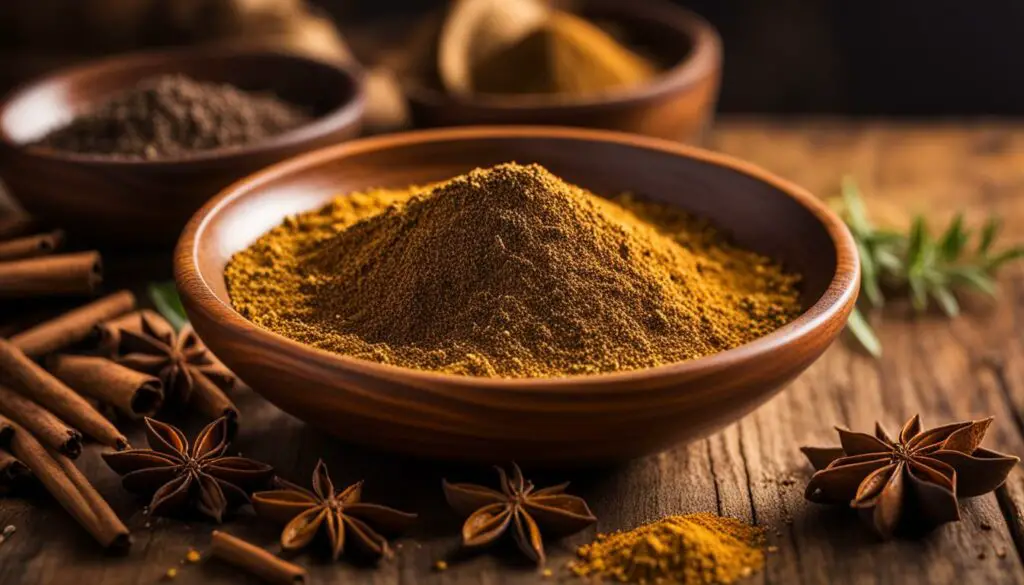
If you’re looking for a flavorful alternative to garam masala, consider using a blend of cumin and allspice. This combination offers a range of flavors that can complement a variety of dishes. Cumin adds earthiness and a hint of smokiness, while allspice contributes warmth and a subtle sweetness. Together, they create a unique and aromatic substitute for masala spice.
To use the cumin and allspice blend as a substitute for garam masala, replace each part of the original spice blend with 1 part cumin and 1/4 part allspice. This ratio ensures a well-balanced flavor profile that captures the essence of garam masala. Adjust the quantities according to your personal taste preferences.
| Garam Masala | Cumin and Allspice Blend |
|---|---|
| Cumin Allspice |
Cumin 1/4 part allspice |
| Cumin Allspice |
Cumin 1/4 part allspice |
| Cumin Allspice |
Cumin 1/4 part allspice |
This cumin and allspice blend can be used in a variety of Indian recipes, such as curries, biryanis, and lentil dishes. It adds depth and complexity to the dishes, creating a rich and flavorful experience. You can also experiment with incorporating this blend into other cuisines, such as Middle Eastern or North African, to add a unique twist.
When using the cumin and allspice blend as a substitute for garam masala, keep in mind that the flavor profile may be slightly different. While it captures some of the key elements of garam masala, it may not have the exact same complexity. However, it still offers a delicious alternative that can elevate your dishes and provide a satisfying culinary experience.
Substitute 3 – Homemade Masala Spice Blend
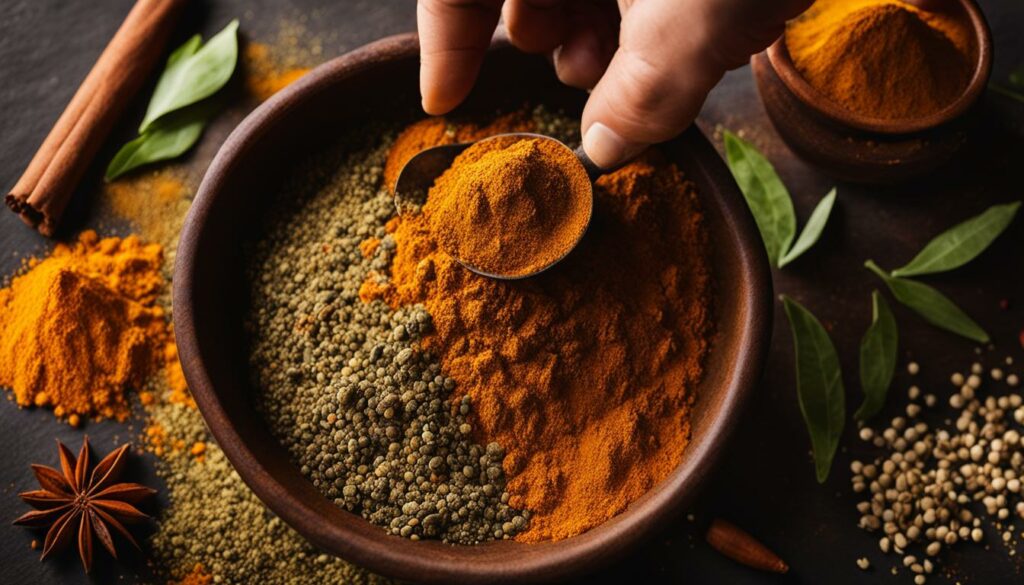
If you prefer to make your own masala spice blend, you can do so by combining equal parts ground fennel seeds, caraway seeds, and cinnamon. This homemade blend can mimic the flavor, aroma, and texture of garam masala. Experiment with the ratios and adjust to your taste preference.
Creating your own masala spice blend at home is a simple and rewarding process. Start by toasting the whole spices on low heat to release their natural oils and enhance their flavors. Once cooled, grind them into a fine powder using a spice grinder or mortar and pestle. Combine the ground fennel seeds, caraway seeds, and cinnamon in equal parts, and store the blend in an airtight container.
Using a homemade masala spice blend allows you to have more control over the flavors and ingredients, making it a versatile substitute for garam masala. You can adjust the ratios of the spices to suit your preferences and experiment with adding other complementary spices like cloves, cardamom, or black pepper. This way, you can create a unique blend that adds depth and complexity to your dishes.
Benefits of Homemade Masala Spice Blend:
- Customizable flavors to suit individual tastes
- Enhanced aroma and texture compared to store-bought options
- No added preservatives or artificial ingredients
- Ability to experiment with additional spices for a unique blend
Using Masala Spice Substitutes in Cooking
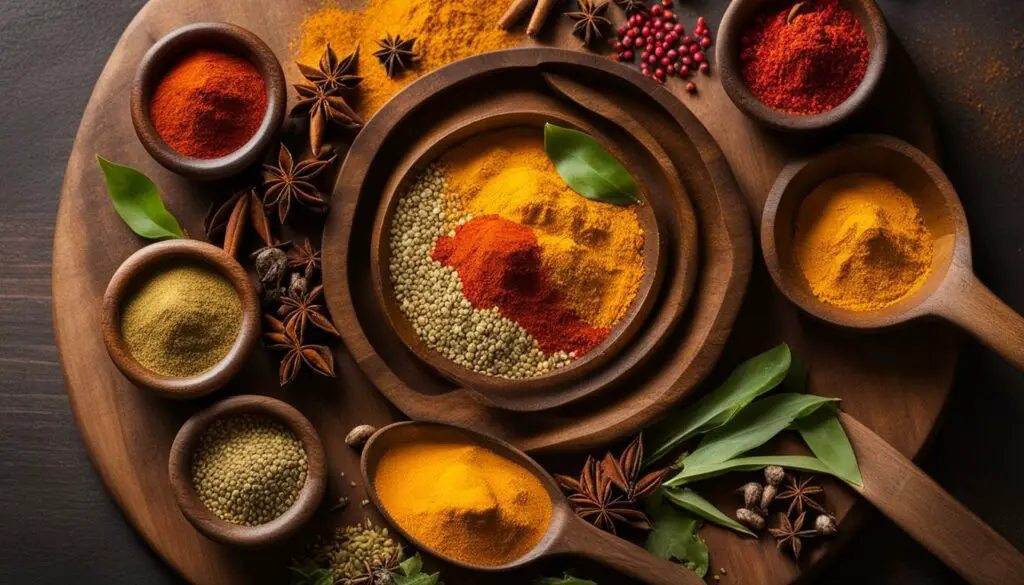
Masala spice substitutes can be a great way to add depth of flavor to a variety of dishes. While garam masala is a beloved spice blend in Indian cooking, there are times when you may not have it on hand or want to try something different. Luckily, there are several authentic masala spice substitutes that can be used to achieve similar flavors and aromas.
One popular substitute is curry powder. Although it has a different flavor profile, it offers a complex blend of spices that can be used in a variety of Indian recipes. When using curry powder as a substitute for garam masala, it is recommended to use a 1:1 ratio. This will help maintain the balance of flavors and ensure that the dish tastes authentic.
Another option for a masala spice substitute is a blend of cumin and allspice. This combination offers flavors reminiscent of cloves, cinnamon, pepper, and nutmeg. To use this substitute, replace each part of garam masala with 1 part cumin and 1/4 part allspice. This will help recreate the unique taste and aroma of garam masala in your dishes.
For those who prefer to make their own masala spice blend, a homemade substitute can be created using ground fennel seeds, caraway seeds, and cinnamon. By experimenting with the ratios of these spices, you can customize the flavor, aroma, and texture to suit your personal taste preferences. This allows you to create a unique masala spice blend that can be used in a variety of recipes.
| Masala Spice Substitute | Ingredients | Ratio |
|---|---|---|
| Curry Powder | A blend of various spices, including turmeric, coriander, cumin, fenugreek, and more | 1:1 |
| Cumin and Allspice Blend | Cumin and allspice | 1 part cumin to 1/4 part allspice |
| Homemade Masala Spice Blend | Ground fennel seeds, caraway seeds, and cinnamon | Adjust to taste |
Using these masala spice substitutes can open up a world of new flavors in your cooking. Try incorporating them into traditional Indian dishes like Bhindi Masala or Chicken Tikka Masala for an authentic taste. You can also get creative and experiment with using them in other cuisines to add a unique twist to your favorite recipes. Whether you’re a novice or an experienced cook, these substitutes can help you achieve delicious and flavorful results.
Tips for Cooking with Spices
When it comes to cooking with spices, mastering the art of balance is essential. Whether you’re using garam masala or one of its substitutes, understanding how to harness the flavors of spices can elevate your dishes to new heights. Here are some valuable tips to enhance your culinary adventures:
Start Small and Adjust
Spices can be potent, so it’s wise to start with a small amount and gradually build up the intensity. This allows you to tailor the flavor to your liking and prevent overpowering your dish. Remember, it’s easier to add more spice than to remove it!
Dry-Roast for Intensified Aroma
Dry-roasting spices before using them can unlock their full potential. Simply heat a dry skillet over medium-low heat and toast your whole or ground spices for a few minutes until they become fragrant. This process intensifies the aroma and deepens the flavors, resulting in a more complex taste profile.
Proper Storage for Freshness
To preserve the freshness and potency of your spices, store them in a cool, dry place away from moisture, heat, and light. Air-tight containers such as glass jars or metal tins are ideal for maintaining their quality. Be sure to label and date your spices to keep track of their shelf life.
By applying these tips, you can confidently explore the realm of spices and create dishes that burst with flavor and aroma. Remember to experiment, trust your taste buds, and have fun as you embark on your culinary spice journey!
References:
- “How to Cook with Spices: 5 Simple Tips” – Food Republic
- “The Art of Cooking with Spices” – The Pioneer Woman
- “A Guide to Using Spices in Your Cooking” – Serious Eats
Conclusion
In conclusion, when it comes to finding the best masala spice substitute, there are a few options that can be explored. Curry powder is a versatile alternative that offers a different but equally complex flavor profile. A blend of cumin and allspice can also provide a unique combination of flavors reminiscent of garam masala. And for those who prefer homemade options, a simple blend of ground fennel seeds, caraway seeds, and cinnamon can mimic the taste of garam masala.
By experimenting with these substitutes, you can discover new and exciting flavors in your favorite dishes. Whether you’re preparing traditional Indian recipes or adding a twist to other cuisines, these masala spice alternatives can add depth and complexity to your cooking.
Remember, when cooking with spices, always consider the balance of flavors. Start with small amounts and adjust the seasoning as you go. Dry-roasting spices before use can enhance their aroma and flavor, and storing them in a cool, dry place will help maintain their freshness.
So, next time you find yourself without garam masala, don’t worry. Try one of these substitutes and embark on a culinary adventure filled with delicious tastes and aromas. Happy cooking!
FAQ
Can I substitute curry powder for garam masala?
Yes, curry powder can be used as a substitute for garam masala. Use a 1:1 ratio when substituting garam masala with curry powder in your recipes.
What can I use as a substitute for garam masala?
If you don’t have garam masala on hand, you can use a blend of cumin and allspice as a substitute. Replace each part of garam masala with 1 part cumin and 1/4 part allspice.
How can I make my own masala spice blend?
To make your own masala spice blend, combine equal parts ground fennel seeds, caraway seeds, and cinnamon. Adjust the ratios to your taste preference.
How can I use masala spice substitutes in cooking?
Masala spice substitutes can be used in a variety of dishes to add depth of flavor. Try using them in traditional Indian recipes like Bhindi Masala or Chicken Tikka Masala, or experiment with incorporating them into other cuisines for a unique twist.
What are some tips for cooking with spices?
When cooking with spices, start with small amounts and taste as you go to adjust the seasoning. Dry-roasting spices before using them can enhance their aroma and flavor. Store spices in a cool, dry place to maintain their freshness.
Can I make my own garam masala at home?
Yes, you can make your own garam masala at home using whole spices. Homemade garam masala often has a more intense flavor and aroma compared to the store-bought variety.
Are there any other alternatives to garam masala?
Yes, besides curry powder and a blend of cumin and allspice, you can experiment with other homemade masala spice blends to mimic the flavor, aroma, and texture of garam masala.
Source Links
- https://rawspicebar.com/blogs/spices-101/garam-masala-substitute
- https://www.allrecipes.com/garam-masala-substitute-8380105
- https://thestonesoup.com/garam-masala-substitutes/
See also:
Leave a Reply